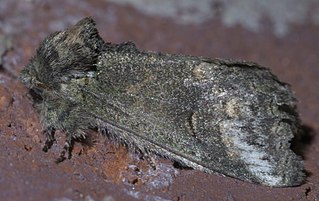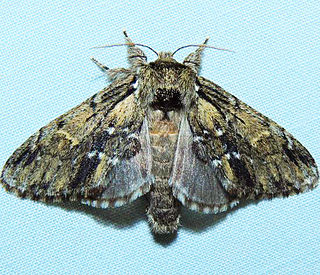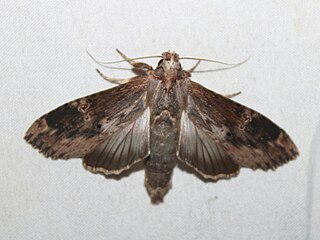Dasylophia seriata, the western legume prominent, is a species of moth in the family Notodontidae. It was first described by Druce in 1887 and it is found in North America.

Heterocampa astarte, the astarte prominent moth, is a species of moth in the family Notodontidae. It was first described by Edward Doubleday in 1841 and it is found in North America.
Heterocampa secessionis is a species of moth in the family Notodontidae. It was first described by Foster Hendrickson Benjamin in 1932 and it is found in North America.
Heterocampa benitensis, the spring snowflake, is a species of moth in the family Notodontidae. It was first described by André Blanchard in 1971 and it is found in North America.

Odontosia elegans, the elegant prominent, is a species of moth in the family Notodontidae. It was first described by Herman Strecker in 1885 and it is found in North America.
Hyparpax aurostriata is a species of moth in the family Notodontidae. It was first described by Graef in 1888 and it is found in North America.
Heterocampa amanda is a species of moth in the family Notodontidae. It was first described by William Barnes and Arthur Ward Lindsey in 1921 and it is found in North America.
Notodonta pacifica is a species of moth in the family Notodontidae. It was first described by Hans Hermann Behr in 1892 and it is found in North America.
Ursia furtiva is a species of moth in the family Notodontidae. It was first described by André Blanchard in 1971 and it is found in North America.

Cecrita lunata is a species of moth in the family Notodontidae. It was first described by Henry Edwards in 1884 and it is found in the western United States and Mexico.
Symmerista zacualpana is a species of moth in the family Notodontidae. It was first described by Max Wilhelm Karl Draudt in 1932 and it is found in North America.
Rifargia bichorda, or Hampson's prominent moth, is a species of moth in the family Notodontidae. It was first described by George Hampson in 1901 and it is found in North America.
Notodonta scitipennis, the finned-willow prominent or base-streaked prominent, is a species of moth in the family Notodontidae. It was first described by Francis Walker in 1862 and it is found in North America.

Clostera brucei, the Bruce's prominent moth or Bruce's chocolate-tip, is a species of moth in the family Notodontidae. It was first described by Henry Edwards in 1885 and it is found in North America.
Datana robusta, the annual buttonweed or robust datana moth, is a species of moth in the family Notodontidae. It was first described by Herman Strecker in 1878 and it is found in North America.

Heterocampa subrotata, the small heterocampa, is a species of moth in the family Notodontidae. It was first described by Leon F. Harvey in 1874 and it is found in North America.
Hyparpax perophoroides, the red-lined yellow prominent or lilac moth, is a species of moth in the family Notodontidae. It was first described by Strecker in 1876 and it is found in North America.
Lacinipolia aileenae is a moth genus or species of cutworm or dart moth in the family Noctuidae. It is found in North America.

Hyperaeschra georgica, the Georgian prominent, is a species of moth in the family Notodontidae. It was first described by Gottlieb August Wilhelm Herrich-Schäffer in 1855 and it is found in North America and parts of Australia.

Nystalea eutalanta, commonly known as Dyar's tropical prominent moth, is a species of prominent moth in the family Notodontidae. It was first described by Harrison Gray Dyar Jr. in 1921 and it is found in North America.







